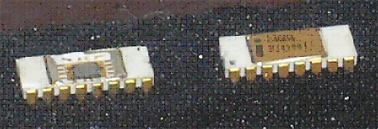Computing History Timeline
Intel 4004 Microprocessor
Table of contents

The 4004 was released in 16-pin CERDIP packaging on November 15, 1971. It was the first computer processor designed and manufactured by chip maker Intel, which previously made semiconductor memory chips. The chief designers of the chip were Federico Faggin and Ted Hoff of Intel, and Masatoshi Shima of Busicom (later of ZiLOG, founded by Federico Faggin at the end of 1974, the first company entirely devoted to microprocessors). Faggin was the project leader and chip designer who developed the random logic methodology with silicon gate that made it possible to fit the microprocessor in one chip in 1970-1971.
T
he 4004 was signed with the initials F.F, for Federico Faggin, its designer. Signing the chip was a spontaneous gesture of proud authorship. It was also an original idea, imitated after him by others. Faggin initially etched the F.F. inside the design. Later he moved them to its border, like the autograph on a work of art. The signature is a particularly poignant testimony because, at the time of its birth, the first microprocessor, far from being considered a milestone by Intel's management, represented a diversion from the mainline business of the company which was memory chips.The birth of the 4004 was an intense moment witnessed by Faggin alone, working into the night in the deserted Intel labs. He had received the 4004 wafers from the manufacturing line at around 6 PM, in January 1971, as people were leaving for the day. With hands trembling and heart pounding he loaded the wafers in the wafer prober and connected it to the tester. As the testing progressed, the tension was gradually transforming into elation as all the critical functions showed to be operating properly.
Originally designed for the Japanese company Busicom to be used in their line of calculators the 4004 was also provided with a family of custom support chips. For each "Program ROM" internally latched for its own use the 4004's 12-bit program address, which allowed 4 KB memory access from the 4-bit address bus if all 16 ROMs were installed. The 4004 circuit was built of 2,300 transistors, and was followed the next year by the first ever 8-bit microprocessor, the 3,300 transistor 8008 and the 4040, an updated version of the 4004. CPU speed reached up to 740 kHz.
As its fourth entry in the microprocessor market, Intel released the CPU that started the microcomputer revolution which was the 8080.
The Intel 4004 is said to have the computing power of the ENIAC, a 1946 supercomputer that weighed 27 tonnes and occupied 63 m2 of floor space.

On 15 November 2006, the 35th anniversary of the Intel 4004, Intel celebrated by releasing the chip's schematics, mask works, and user manual.
Citations
A Brief History of Computing - Microprocessors
http://trillian.randomstuff.org.uk/~stephen/history/timeline-CPU.html
Date of download – 22/01/2008
Federico Faggin
The Intel 4004
http://www.intel4004.com/sign.htm
Date of download – 22/01/2008
Intel 4004
http://en.wikipedia.org/wiki/Intel
This page was last modified 08:33, 22 January 2008.
Date of download – 23/01/2008

